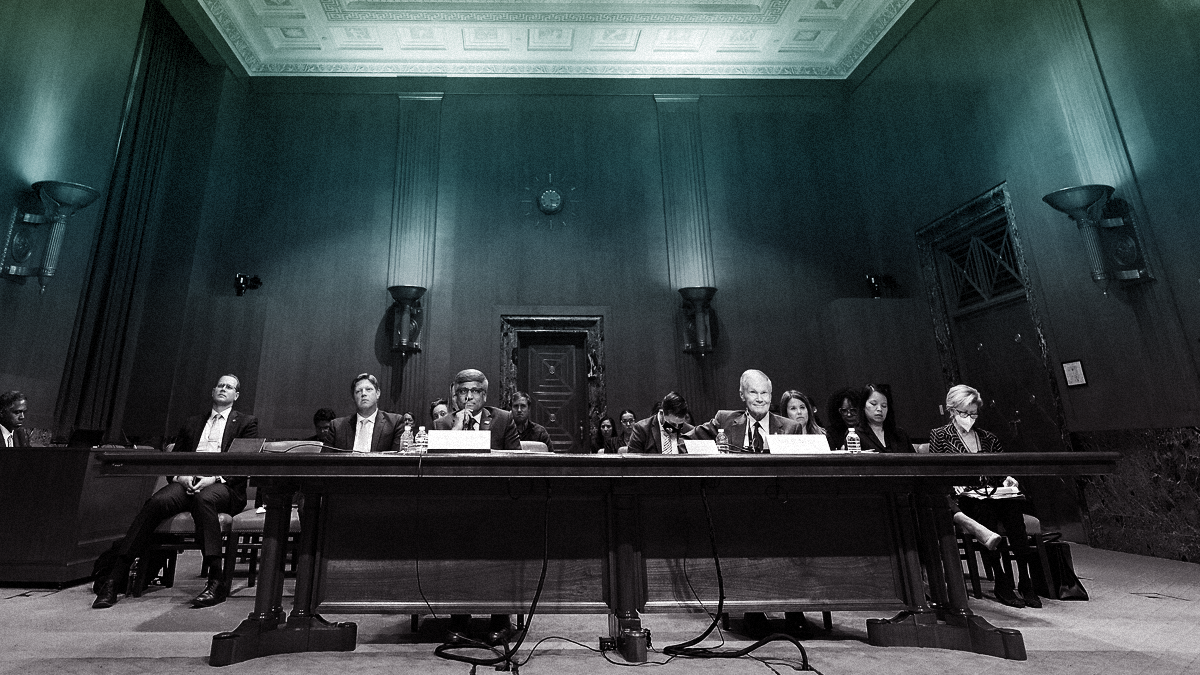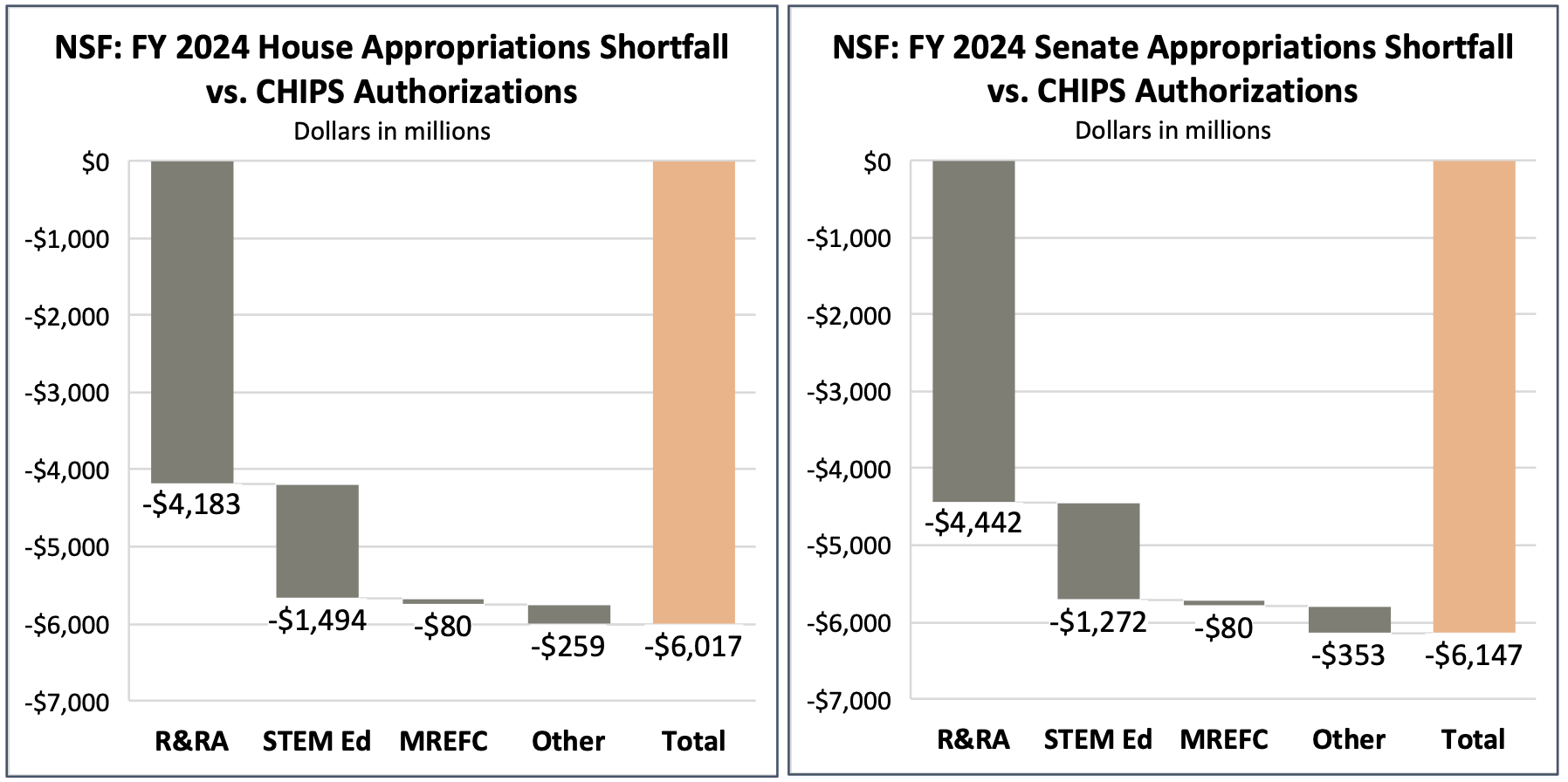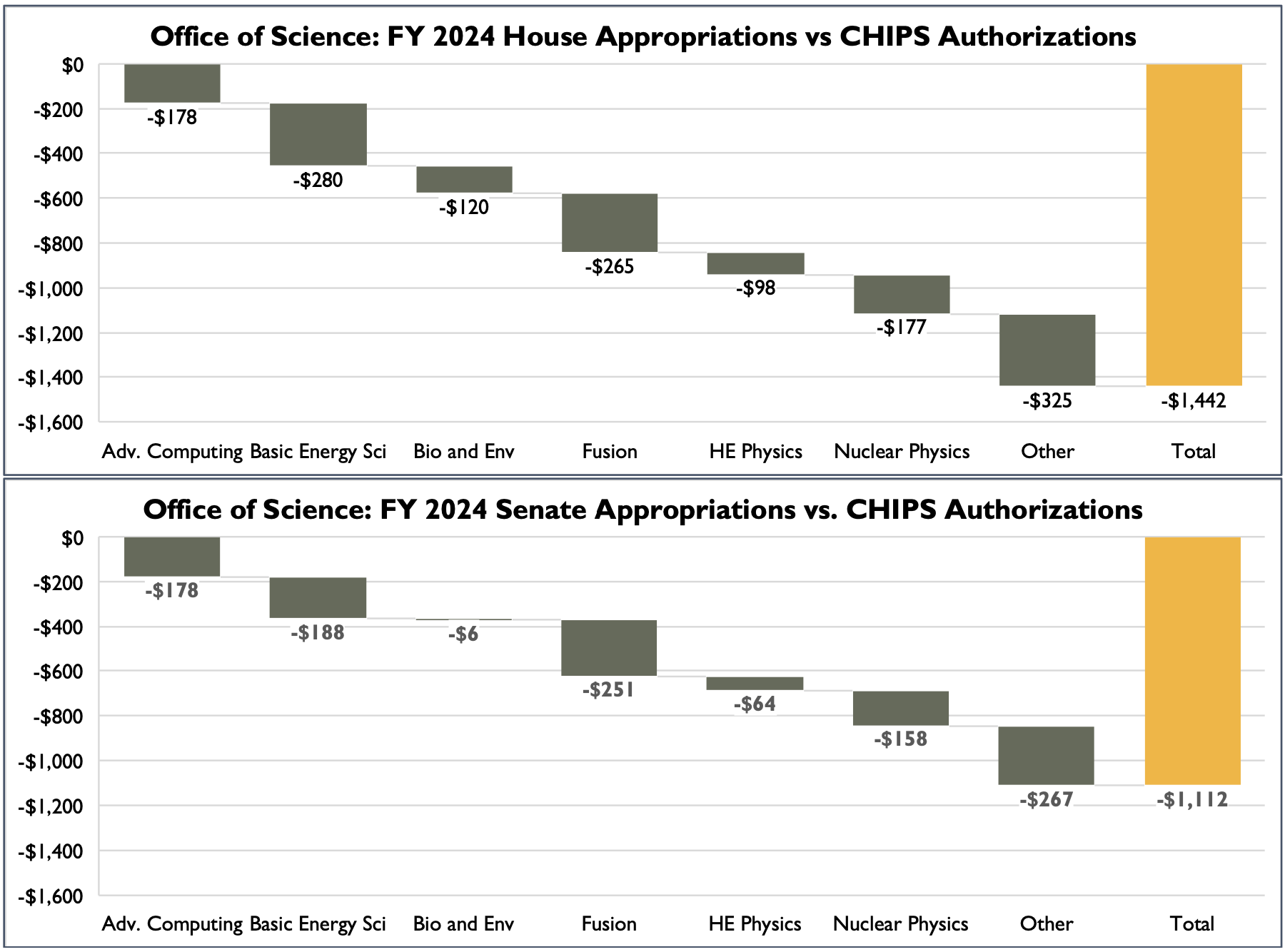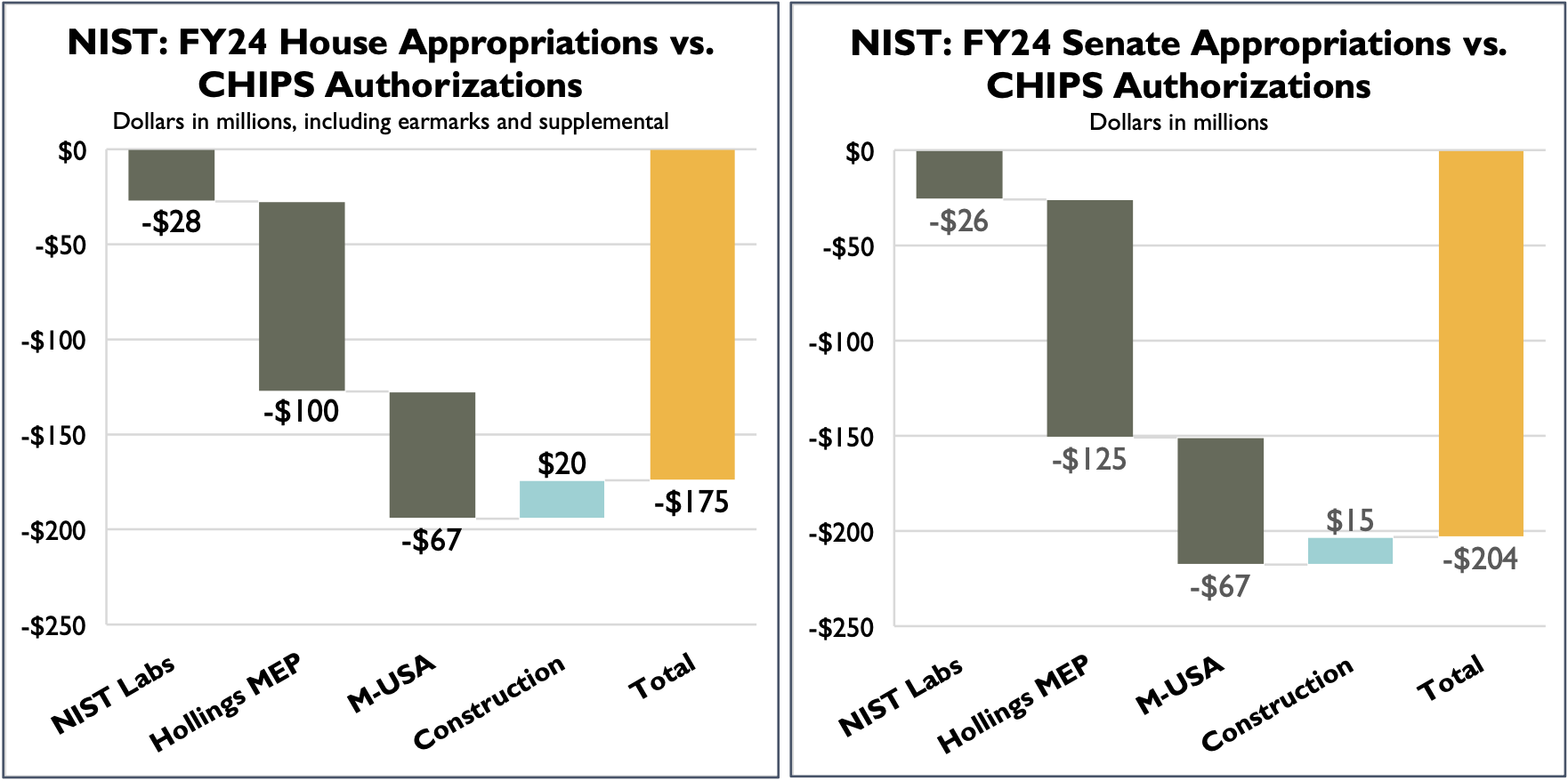
CHIPS and Science: FY24 Research Appropriations Short by Over $7 Billion
When Congress adopted the CHIPS and Science Act (P.L. 117-167) in 2022 on a bipartisan basis, it was intended to strengthen the United States’ ability to compete and to invest in solutions for national challenges. Beyond semiconductors, CHIPS and Science took an array of concrete steps to strengthen innovation: it provided strategic focus for the federal R&D enterprise, created investments in U.S. workers and regions, expanded the funding toolkit, and authorized boosts for science and education across the spectrum.
Such a varied approach is critical in the race for technological and economic advantage, as other nations mount challenges to U.S. leadership – particularly China, which has seized the lead in several key technology areas after years of accelerated investment. But despite this impetus, appropriations for research agencies have fallen quite short of the CHIPS and Science targets. Following an FY 2023 omnibus shortfall of nearly $3 billion, FY 2024 appropriations to date for research agencies are approximately $7.5 billion below authorized levels (see graph).
This report provides a detailed breakdown of accounts and programs for these agencies and compares current appropriations against those authorized by CHIPS and Science, as a reference and resource for policymakers and advocates.

CHIPS and Science Background
CHIPS and Science took manifold steps to strengthen the U.S. science enterprise. A conceptual throughline is the establishment of key technology focus areas and societal challenges defined in Section 10387, shown in the table below. While not the only priorities for federal R&D, these focus areas provide a framework to guide certain investments, particularly those by the National Science Foundation’s new technology directorate.
These key technology areas are also relevant for long-term strategy development by the Office of Science and Technology Policy and the National Science and Technology Council, as directed by CHIPS and Science. Several of the technology areas also appear on the Defense Department’s Critical Technologies list.
While much of the focus has been on semiconductors, the activities covered in this report constitute the bulk of the “and Science” portion of CHIPS and Science. While a full index of all provisions is not the goal here, it’s worth remembering the sheer variety of activities authorized in CHIPS and Science, which cut across areas including:
- Fundamental science and curiosity-driven research funded by science agencies at federal labs, universities, and companies. CHIPS and Science covered multiple disciplines but has a particular emphasis on the physical sciences, math and computer science, and engineering. Several of these disciplines have fallen dramatically within the federal portfolio in recent decades.
- Use-inspired research, translation, and production. Elements of CHIPS and Science sought to expand the ability of federal agencies to make strategic investments in emerging technologies, move new advances through the innovation chain, and work with external partners to enable the manufacture of new technologies and strengthen supply chains.
- Regional innovation. A major element of the above is emphasis on expanding the geographic footprint of federal investment, most notably through the new Regional Technology and Innovation Hubs program. The program received $500 million out of an authorized $10 billion in the FY 2023 omnibus.
- STEM education and workforce. The Act expands or creates numerous programs to foster STEM skills, opportunity and experience among students and young researchers, including through entrepreneurial fellowships, student and educator support, and apprenticeships and worker upskilling initiatives.
- Research facilities and instrumentation at national labs and universities across the country, including modernization of aging infrastructure, construction of cutting-edge user facilities, and grants for mid- scale research infrastructure projects.
Aggregate Agency Appropriations
In the aggregate, CHIPS and Science authorized three research agencies – the National Science Foundation (NSF), the Department of Energy Office of Science (DOE SC), and the National Institute of Standards and Technology (NIST) – to receive $26.8 billion in FY 2024, a $4.5 billion boost from the FY 2023 authorizations. House and Senate appropriations to this point – including the House Commerce, Justice, Science and Related Agencies bill, which was not adopted by the Appropriations Committee before the August break – amount to somewhat above $19 billion in both, representing a more than $7 billion or approximately 28% shortfall, in each (see Table 1 below). In fact, these aggregates represent not only a shortfall below the FY 2024 authorization, but a reduction of $250 million and $421 million, respectively, below FY 2023 appropriations, when factoring in FY 2023 NSF and NIST funding provided as supplemental.
The gap for NIST grows larger when accounting for earmarks, which amounted to approximately $119 million in the House and $199 million in the Senate. Excluding earmarks, the NIST appropriation totals for FY 2024 result in shortfalls below the authorization of $294 million or 18% in the House, and $403 million or 24% in the Senate.
Agency Breakdowns
National Science Foundation
NSF is at the core of the CHIPS and Science goals in manifold ways. It boasts a long-term track record of excellence in discovery science at U.S. universities and is the first or second federal funder of research in several tech-relevant science and engineering disciplines. It also seeks to boost the talent pipeline by engaging with underserved research institutions and student populations, supporting effective STEM education approaches, and providing fellowships and other opportunities to students and teachers.
CHIPS and Science also expanded NSF’s ability to drive technology, innovation, and advanced manufacturing, augmenting existing innovation programs like the Engineering Research Centers and the Convergence Accelerators with new activities like the Regional Innovation Engines.
As seen in Table 2, the FY 2024 appropriations for NSF are roughly $6 billion or 39% below the CHIPS and Science authorization. The agency toplines are also 2.5% and 3.8% below FY 2023 figures in total, including FY 2023 supplemental spending.

In both the House and the Senate, FY24 Appropriations fall far short of CHIPS authorizations across research and education accounts.
Research & Related Activities (R&RA). R&RA is the primary research account for NSF, supporting grants, centers, instrumentation, data collection, and other activities across seven research directorates including the new Technology, Innovation, and Partnerships (TIP) directorate. These directorates play a foundational role in driving U.S. leadership in biology, computing and information science, engineering, geoscience, math and computer science, and social science, as well as integrated and international programs. R&RA can likely absorb substantial additional funding: the agency must routinely leave thousands of high-scoring grant proposals on the table for lack of funding. For instance, in FY 2021, NSF had to leave unfunded over 4,000 proposals amounting to $4.1 billion ranked “Very Good” or better.
In report language, Senate appropriators encourage NSF to initiate a contract with the National Academies to pursue a CHIPS and Science-mandated assessment of the key technology focus areas. For FY 2024, Senate appropriators have provided the same funding as FY 2023 for the Regional Innovation Engines, quantum information science activities, and AI research. The EPSCoR program received $275 million, a $20 million increase. House appropriators have not yet released appropriations report language for NSF.
STEM Education. The Directorate for STEM Education houses NSF activities across K-12, tertiary education, learning in informal settings, and outreach to underserved communities. CHIPS and Science authorized increased funding for multiple individual programs including Graduate Research Fellowships, Robert Noyce Teacher Fellowships Program, CyberCorps, and the new Centers for Transformative Education Research and Translation, among others. These programs serve an array of functions, including STEM teacher recruitment, support for the federal cybersecurity workforce, and support for a range of learners and institutions including veterans and underrepresented minorities.
Senate appropriators provided a mix of small changes, flat funding, or trims from FY 2023 levels to several NSF STEM programs including graduate and Noyce fellowships, the HBCU Undergraduate Program and the Centers for Research Excellence in Science and Technology (CREST). In most cases these figures were all well short of CHIPS and Science targets. Notably, Senate appropriators provided $40 million for a National STEM Teacher Corps pilot program and encouraged NSF to establish a Centers for Transformative Education Research and Translation, both authorized in CHIPS and Science.
Department of Energy Office of Science
The Office of Science (SC) is the largest funder of the physical sciences including chemistry, physics, and materials, all of which contribute to the technology priorities in CHIPS and Science. In addition to funding Nobel prizewinning basic research and large-scale science infrastructure, the Office also funds workforce development, use-inspired research, and user facilities that provide tools for tens of thousands of users each year, including hundreds of small and large businesses that use these services to drive breakthroughs. More than two thirds of SC-funded R&D is performed at national labs. SC also supports workforce development and educational activities for students and faculty to expand skills and experience.
As seen in Table 3, topline FY 2024 appropriations have been over $1 billion or at least 12% short of the CHIPS authorization in both chambers. House appropriations have been flat from the FY 2023 omnibus while Senate appropriators have provided SC with a 4% increase overall.

Advanced Scientific Computing Research (ASCR) funds research in AI, computational science, mathematics, and networking. Among CHIPS and Science priorities, ASCR will begin to establish a dedicated Quantum Network along with other research, testbeds, and applications in FY 2024. CHIPS and Science authorized $31.5 million in FY 2024 for the QUEST Act, to give U.S. researchers access to quantum hardware and research cloud resources, while House appropriators have provided up to $15 million. CHIPS also authorized $100 million for provision of quantum network infrastructure. Senate appropriators directed DOE to provide an update on its plan to sustain U.S. leadership in advanced computing including in AI, zettascale computing, and quantum computing.
Basic Energy Sciences (BES), the largest SC program, supports fundamental science disciplines with relevance for several CHIPS technology areas including materials, microelectronics, AI, and others, as well as extensive user facilities and other novel initiatives. CHIPS and Science authorizations for FY 2024 included research and innovation hubs related to artificial photosynthesis ($100 million) and energy storage ($120 million). Both committees funded the innovation hubs on these topics at $20 million and $25 million, respectively. CHIPS also authorized $50 million per year for carbon materials and storage research in coal-rich U.S. regions.
Biological and Environmental Research (BER) supports research in biological systems science including genomics and imaging, and in earth systems science and modeling. BER programs have fared quite differently in appropriations, with House appropriators reducing funding by $82 million or 9% below FY 2023 omnibus levels, while BER would receive a $32 million or 4% boost in the Senate.
Fusion Energy Sciences (FES) supports research into matter at high densities and temperatures to lay the groundwork for fusion as a future energy source. Appropriations thus far have provided far less than requested for public-private partnerships to support and expand the domestic fusion industry. The Milestone-Based Development Program, to develop technology roadmaps and achieve progress toward fusion pilot plants, would receive $35 million in the House and not less than $25 million in the Senate, versus a combined request of $135 million for the milestone program and the Innovation Network for Fusion Energy (INFUSE) program, which enables industry partnerships with national labs and American universities.
Energy Earthshots are a crosscutting DOE initiative to tackle challenges at the nexus of basic and applied R&D through multidisciplinary team science, thus enabling DOE to better achieve progress in the CHIPS- identified advanced energy technology focus area. Appropriations thus far would dramatically scale back SC’s Earthshot investments from FY 2023 levels. House appropriators would provide $20 million and Senate appropriators $67 million for SC’s portion of the Earthshot initiative, versus FY 2023 funding of $100 million and an FY 2024 request level of $175 million. Ongoing Earthshots address hydrogen, energy storage, carbon removal, enhanced geothermal, offshore wind, industrial heat, and clean fuels, with additional projects anticipated in FY 2024.
Quantum Information Science is a priority for both CHIPS and Science and in the Administration’s request, but appropriations remain limited. House appropriators have provided not less than $245 million, same as the FY 2023 omnibus level, while the Senate provided a $10 million or 4% increase.
National Institute of Standards and Technology
While smaller than the other agencies covered here, NIST plays a critical role in the U.S. industrial ecosystem as the lead agency in measurement science and standards-setting, as well as funder of world-class physical science research and user facilities. NIST R&D activities cover several CHIPS And Science technology priorities including cybersecurity, advanced communications, AI, quantum science, and biotechnology. NIST also boasts a wide-ranging system of manufacturing extension centers in all 50 states and Puerto Rico, which help thousands of U.S. manufacturers grow and innovate every year.
As seen in Table 4, the NIST appropriation – which doesn’t include mandatory semiconductor funding – is 11% to 12% below the CHIPS and Science level for FY 2024. These figures include earmarks of $119 million and $199. Excluding earmarks, the NIST shortfalls are 18% in the House and 24% in the Senate.

Scientific and Technical Research Services (STRS) is the account for NIST’s national measurement and standards laboratories, which pursue a wide variety of CHIPS and Science-relevant activities in cybersecurity, AI, quantum information science, advanced communications, engineering biology, resilient infrastructure, and other realms. STRS also funds two user facilities, the NIST Center for Neutron Research and the Center for Nanoscale Science and Technology.
Excluding FY 2024 House and Senate earmarks, NIST lab programs would receive cuts of approximately $50 million under current appropriations.
House report language for NIST has not yet been adopted, but Senate appropriators approved the requested $5 million increase for quantum information science, while providing cybersecurity funding no less than FY 2023 levels and holding AI research flat at FY 2023 enacted levels. Critical and emerging technology investments received a $12 million increase versus the requested $20 million boost.
Industrial Technology Services is the overarching account funding the Hollings Manufacturing Extension Partnership (MEP) and the Manufacturing USA innovation network. As can be seen in Table 4, these programs collectively faced a much greater authorization shortfall than NIST lab programs.
Appropriations in Historical Context
Relative funding for NSF, SC and NIST has evolved over the decades, as seen in the graph on the following page. As a share of the U.S. economy, funding for the three agencies experienced marked decline in the late 1970s and early 1980s, dropping to 0.05% of U.S. GDP in the mid-1980s. Beginning in the later Reagan era and continuing into the Clinton era, the three agencies experienced a recovery and rise through the late 1990s tech bubble.
After peaking in FY 2003 at 0.083 percent of GDP, the three agencies have undergone a period of relative funding stagnation. Apart from the transient Recovery Act funding spike, agencies’ combined funding has wavered around 0.075% of GDP. Much of this stagnant is due to the discretionary caps under the Budget Control Act, which took effect beginning in FY 2012.
CHIPS and Science provided NIST mandatory funding specifically earmarked for semiconductor R&D and industry incentives but left the range of other technology priorities to be funded through annual discretionary appropriations, which as described have been limited. Under current appropriations, agency discretionary budgets would likely drop to near 0.07% of U.S. GDP, their lowest point in 25 years.

Here’s how CHIPS and Science funding is shaping up in the battle over the federal budget.
A nondefense-only cap approach may mean estimated cuts of 28% in FY 2024, and near 40% over the next decade, for science agencies like the National Institutes of Health, the National Science Foundation, and NASA.